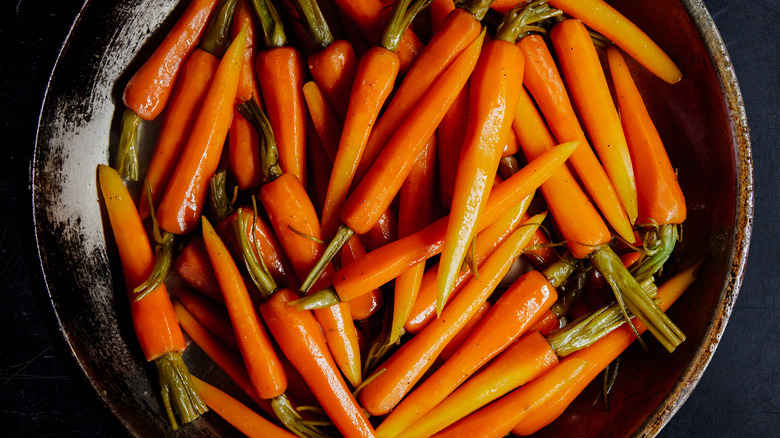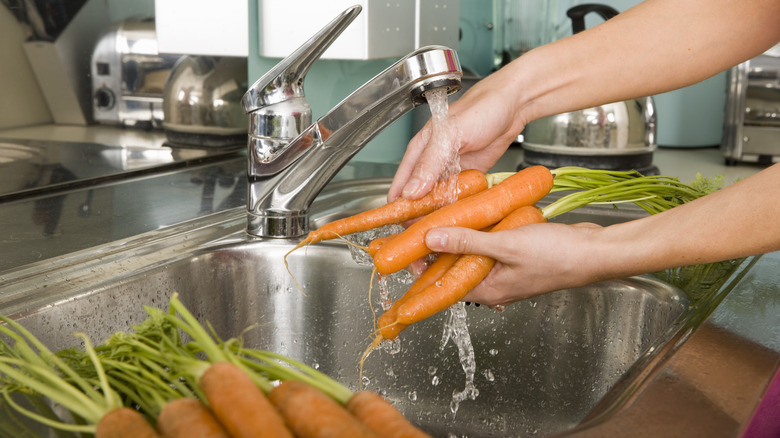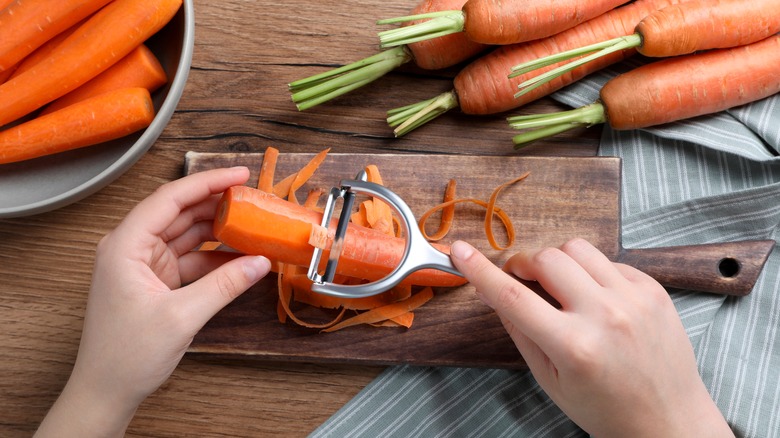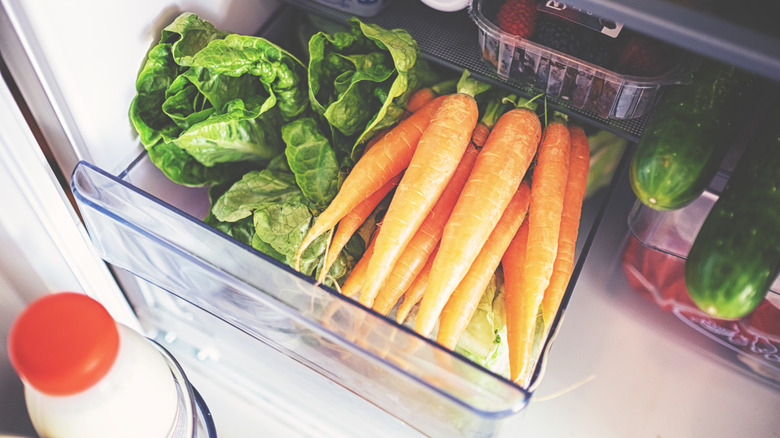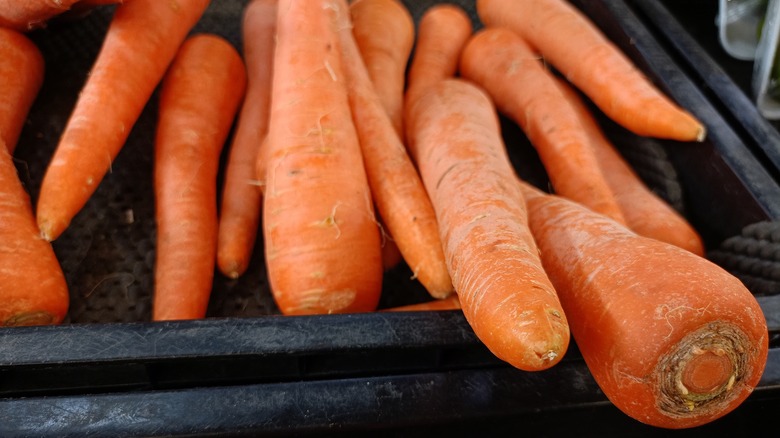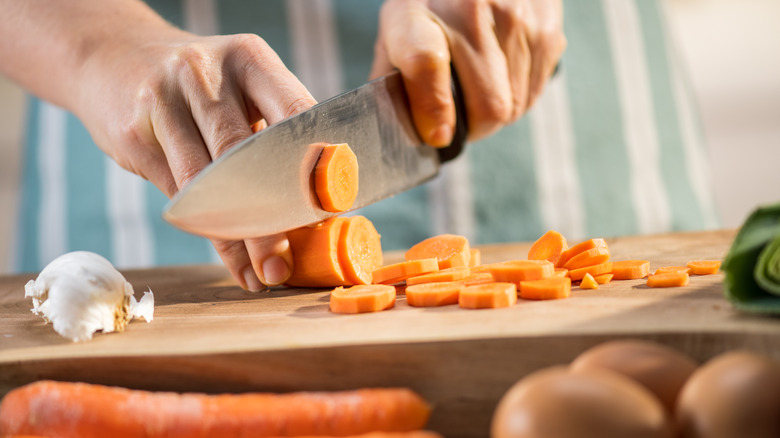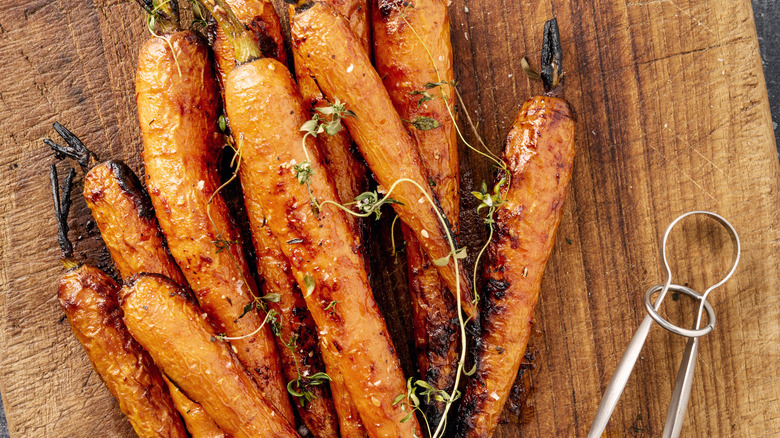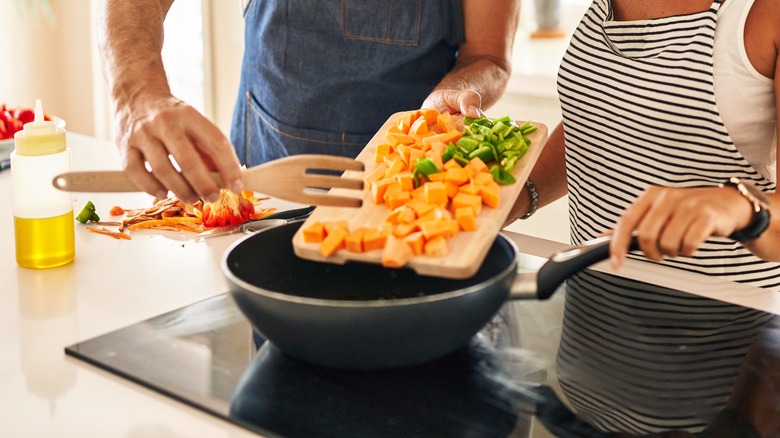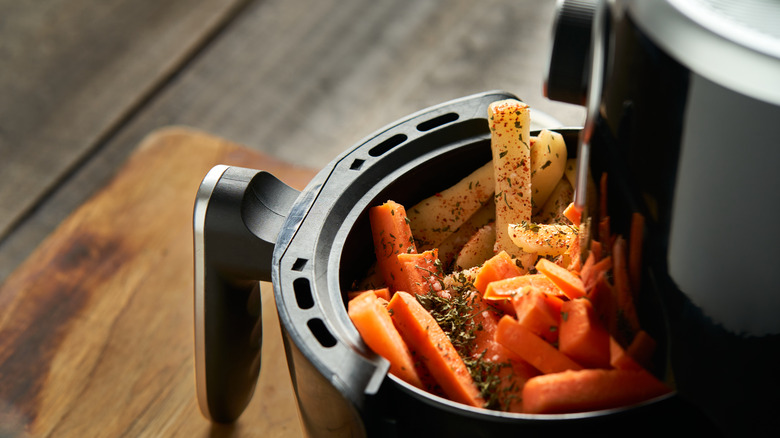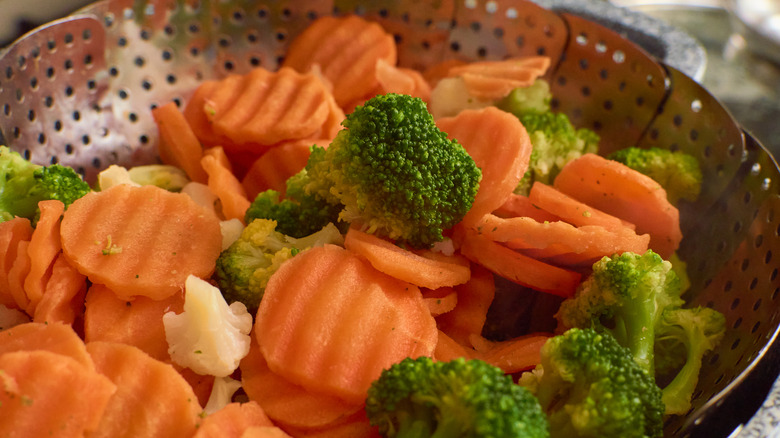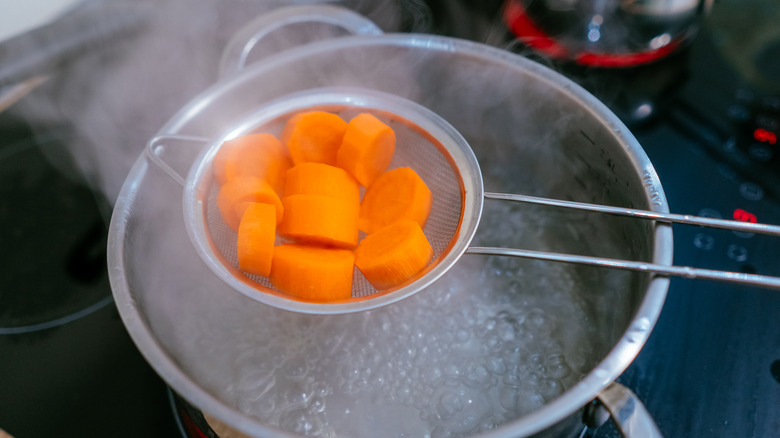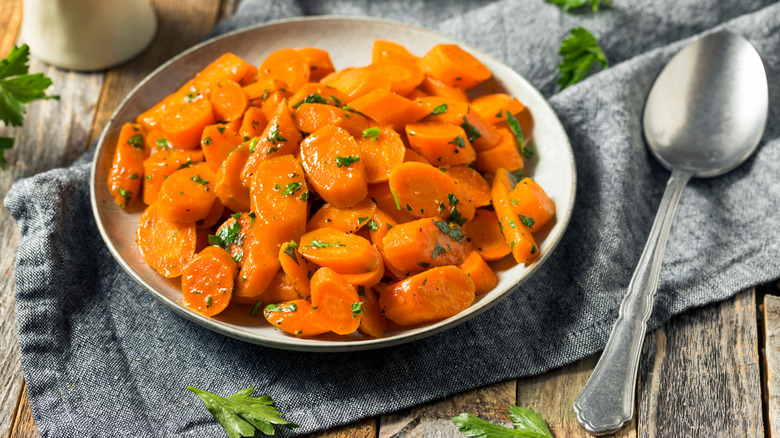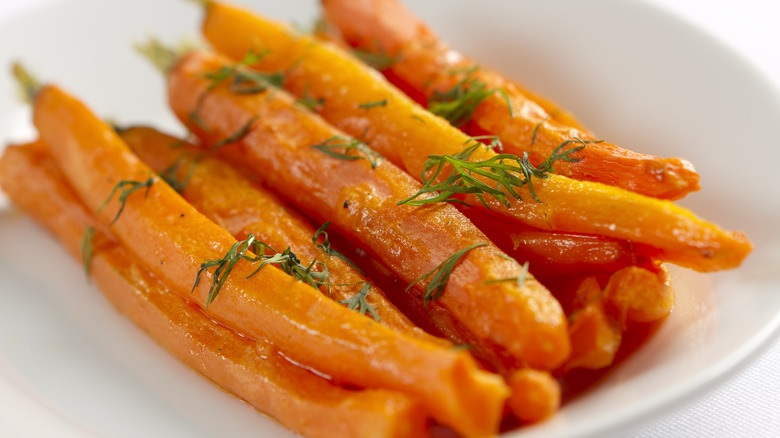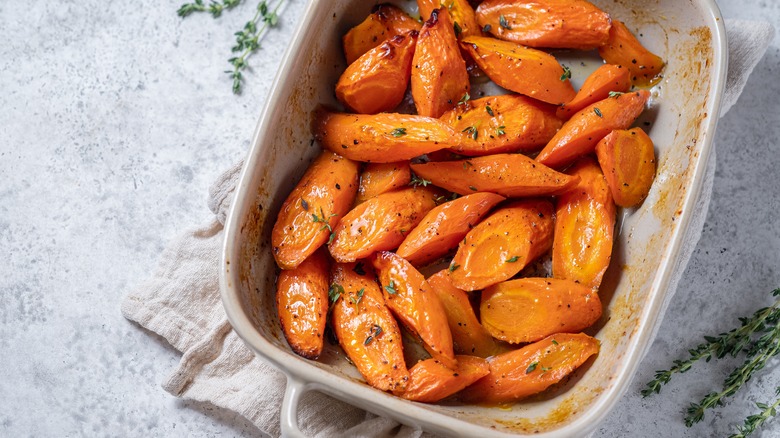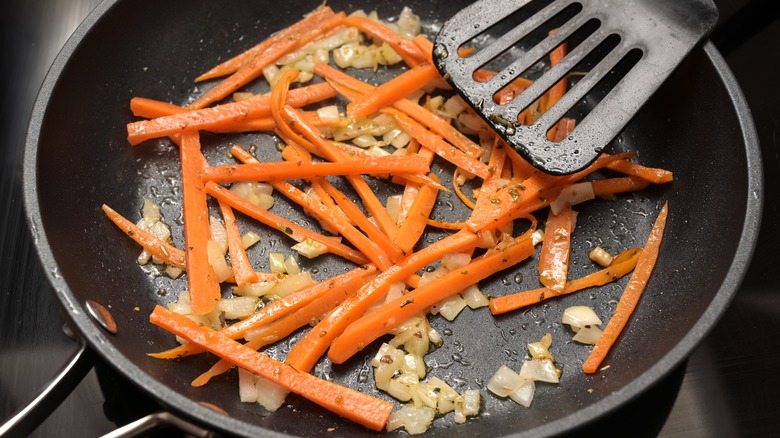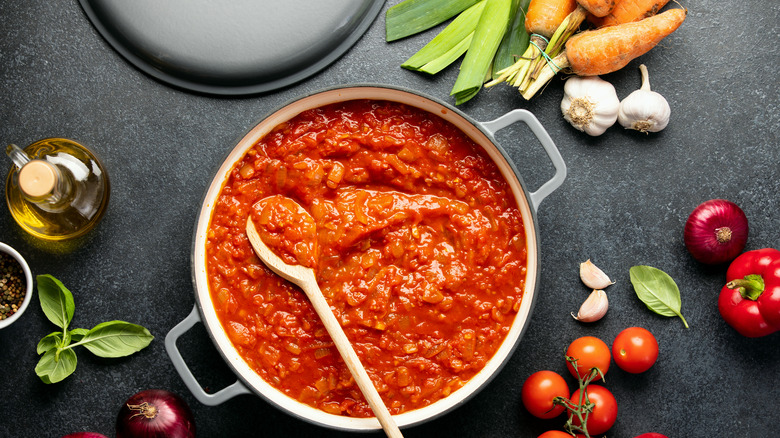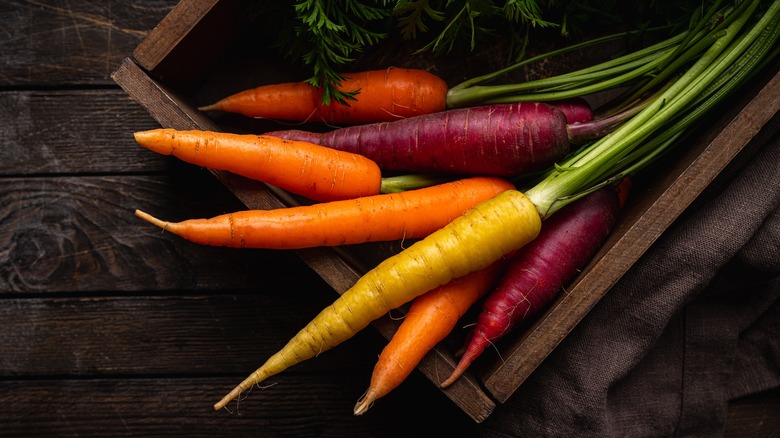Essential Tips You Need When Cooking With Carrots
Carrots are a tasty, nutritious, versatile vegetable that can be enjoyed in many different recipes. They make the base for many dishes, can be cooked in numerous ways, and go with a wide range of spices and sweeteners, so the sky's the limit. As such, you may think cooking them is easy, and generally, it is. However, there is a collection of beneficial things you can do to make the most of them in your recipes. From prep to storage to various cooking methods to spices and more, there are best practices that help you utilize carrots to their fullest potential every time you buy and eat them.
I did the research, considered my personal experience as a vegetarian cooking carrots, and referenced numerous chef recommendations and recipes across the web to compile a list of carrot cooking tips that you have to try. Keep reading to learn essential tips you need when cooking with carrots so you can take them to the next level in all of your cooking ventures.
Start by giving carrots a good scrub
Before you even think about cooking a carrot, you must start by giving them a good scrub. After all, they are root vegetables, so they are likely to have a considerable amount of dirt on them after being pulled from the ground. Even if you buy carrots that don't have visible dirt on them, it is best to always start by washing them clean. Of course, the one exception to this is if you buy pre-skinned carrots, like shredded or baby carrots, which come ready for consumption.
Fortunately, cleaning a carrot is simple and doesn't require any cleaner. If you plan on eating a carrot without the skin, start by peeling it. Then, give it a rinse with cold running water. If you want to keep the skins on, which is fine, you will have to put slightly more effort into cleaning a carrot. Hold it under cold running water, just like you would if it had been peeled first, but spend a bit more time scrubbing the skin to ensure you remove any leftover dirt. If you have a bristled vegetable brush, now is the time to put it to use, but even if you don't, rubbing it with your hands should suffice.
Don't peel carrots until right before cooking
Compared to other vegetables, carrots last for a pretty long time in the fridge. When peeled or chopped, they can last about two or three weeks. However, our experience has shown us that if you keep the skins on, they typically last for three to four weeks. So, in a best-case scenario, you may even be able to double the amount of time they stick around before spoiling by simply leaving the skins on. Sure, some carrots come pre-peeled, but if you want to stock up and have yet to make any immediate plans for cooking them, it is best to buy and store them with their skins on.
If you buy baby carrots, like many of us do, to save on prep time, you may have noticed that they develop a white blush on their exteriors after being left in the fridge for a considerable amount of time. While discoloration can often indicate spoilage, this is not always the case with carrots. Baby carrots are always peeled, and as a result, they start drying out faster than a whole, intact carrot. This is a perfect example of why leaving the skins on matters.
Store carrots properly for maximum taste and longevity
As we mentioned, keeping the skins on carrots until right before use helps them retain their freshness, but there is more to proper storage than that alone. To start, you want to keep them out of sunlight, so the fridge is perfect. However, there are two schools of thought regarding proper carrot storage in the refrigerator, both of which improve longevity and are worth trying at home.
The first recommendation for proper carrot storage involves keeping them in a sealed container with a shallow water bath. This ensures maximum juiciness and pretty much guarantees they won't dry out. The second method is to keep carrots dry in an airtight bag or storage container. While both options have brought us success, the key is not keeping carrots in the bag they come in from the store because it isn't airtight.
Regardless of which storage method you decide to practice in your home, they both advise you to remove the tops before putting them in the fridge. The leafy tops draw moisture away from the root, potentially diminishing the taste and texture before you get a chance to enjoy them. Leaving the leaves on can also cause unwanted condensation inside the storage container. We also recommend keeping carrots away from ethylene gas-producing fruits in the fridge because they accelerate ripening. However, if you keep your carrots in an airtight container, what you store them next to shouldn't be an issue.
Leave the skins on your carrots to keep all the nutrition
Most people peel carrots, but it is not necessary. Keeping them on ensures you get the maximum amount of vitamins and nutrition when you eat them. The highest concentration of niacin and vitamin C exists in the peel of a carrot, even though they still exist in high amounts underneath the skin in the intermediate layer. Vitamin C is an antioxidant that boosts the repair and development of crucial body tissues like collagen, bones, teeth, and wound healing. It also helps ensure your immune system is functioning correctly, so waste any?
The skin also contains the highest amounts of beta carotene found in a carrot, but again, there are still some in the other layers. Beta carotene is another antioxidant known for boosting health and protecting the body from damaging free radicals. Sounds great, right? And considering you get to skip the extra step of peeling, eating the skins is sounding better and better. Sure, there is still an abundance of nutritional value in peeled carrots, but leaving the skins on allows you to soak up every single bit of nutrition the carrot has to offer. Of course, if your carrots are extremely dirty and cleaning the skins appears to be a lot of work, you don't have to feel bad about peeling them, either.
Slice uniform pieces to ensure even cooking
Something any chef will tell you is that cutting ingredients to a similar size and shape is essential, and this applies to carrots. That's because cutting ingredients in uniform sizes ensures they all cook through in the same amount of time. If you disregard this and cut your carrots, or any vegetables for that matter, in varying-sized pieces, they won't cook evenly, and some will be ready while others still need some additional time to cook through. Due to the density of carrots and how long they can take to cook when in larger chunks, this is particularly important. If you are eating carrots raw, who cares if the pieces aren't exact? But when cooking them, uniform shapes are ideal.
You're probably not a professional chef with a super sharp, expensive set of kitchen knives, but that doesn't mean you can't achieve precise cuts of carrots at home. Once you determine the right size and shape for your recipe, take your time dicing so you get pieces that are as even as possible. If this isn't your strong suit, you can also chop carrots with a mandoline. This helpful kitchen tool is capable of slicing an array of different shapes and thicknesses, and best of all, they will all be the same size.
Roast carrots for a crispy exterior and a yummy charred taste
If you prefer carrots with a crispy exterior, roasting should be your go-to cooking method. Roasted carrots are our favorite, so we have lots of experience cooking them this way. When done correctly, not only do they have a nice crunchy exterior, but they also have a smooth, soft inside and a slightly charred flavor that is truly delicious. Roasting carrots may not be the fastest method because you have to preheat the oven, but once they're in, they require almost no effort at all. So, as a bonus, you have more time to spend on other components of your meal.
To roast carrots, you want to start with a hot oven. While it depends somewhat on the size of your carrot chunks, 425 F should do the job. You also want to toss them in olive oil and probably a bit of salt and pepper at the very least before you start cooking them. In addition, it is important to cut large, thick slices of carrots when roasting because they will shrink while they are cooking in the oven. Lastly, make sure to leave space between each piece to prevent inadvertently steaming them. While they would still be edible, if you accidentally steam carrots due to close proximity, they won't develop the desired crispy texture.
Sauté and caramelize carrots for tender insides and crispy outsides
Sautéing carrots is a quick and easy way to achieve crispy exteriors with tender insides. Sautéed carrots make a perfect side dish all by themselves, but sautéed carrots also combine well with countless ingredients and go in numerous recipes. So, if you want to be a carrot cooking pro, mastering simple sautéed carrots is key. Fortunately, all you have to do is toss them in a hot pan with olive oil and occasionally stir until they are fork-tender. Typically, this takes anywhere from four to 10 minutes, depending on the size of the pieces. You also want to season them to taste. The spices you use can vary, but at the very least, you want to sprinkle a bit of salt and pepper on them for optimal flavor.
If you want to take it a step further, you can easily turn sautéed carrots into caramelized carrots. You only need to give them some additional time in the pan. The extra time allows the carrots to crisp up even further and gives them a charred taste that borders on roasted flavor. Unlike caramelized onions, many caramelized carrot recipes call for a glaze made of some kind of sweetener. However, it is not required.
Air fry carrots for the perfect crunchy texture
Air frying carrots is an excellent alternative to roasting. They still have a crispy texture and a slightly charred flavor, but air fryers are much faster than an oven. They also have a high-powered fan inside, so they work more like a convection oven and don't require preheating, both of which lead to rapid results. In addition, air-frying carrots open up a world of healthy appetizers, snacks, and entrée recipes. From carrot chips to roasted carrot sticks to crunchy spirals, air fryers have you covered.
Air-fried carrots are best with a slight coating of oil and, of course, some seasoning. However, oil is not necessarily needed, so feel free to skip it if you want a healthier alternative. Either way, air fryers do a great job cooking veggies with minimal oil, so be conservative when tossing your carrots. You can air fry carrots in almost any shape and size you want. If you prefer a super crispy texture, cut thin slices. If you want a juicier bite, thicker chunks and sticks are better. We like to air fry our carrots at 360 F, and depending on the size and recipe, they typically take anywhere from 10 to 18 minutes to cook. Cook them longer for added crispiness, and always toss them halfway through. Other than that, it's basically impossible to mess up air-fried carrots.
Steam or boil carrots if you want to keep things simple
Boiling and steaming are the most straightforward methods of all. They are super fast, don't require any stirring, and you can hold off on seasoning until the end. All you have to do is throw them in or above boiling water, wait a few minutes, and you're good. When boiling carrots in water, baby carrots only need about six to eight minutes to cook, and sliced carrots only need about four to five. You will know they're done when a fork easily penetrates them, hence the term fork-tender.
As you probably know, steaming vegetables allows them to retain more of their inherent nutrients compared to boiling. So, steaming is an outstanding option if you want a more nutritious, low-effort carrot cooking option. If you have a handy steamer appliance, carrots only take approximately eight minutes to cook through. You can expect some slight variation in the time based on the size and quantity of the carrots, but that is to be expected. If you don't have a specific appliance for steaming, you can also do it in a double broiler or steaming basket on a stovetop or in a microwave. A frying pan with a shallow water bath and a lid also works. Whichever one of these steaming methods you use, four to eight minutes should be plenty of time to achieve fork-tender carrots.
Parboil carrots to speed up cooking times
As we've discussed, carrots often take much more time to cook than other vegetables, especially leafy ones. To avoid having to calculate tricky cook times and add additional veggies to a recipe at varying intervals, you can parboil carrots to give them a head start. When parboiled, they will cook up much faster. As a result, you'll be able to add them along with other vegetables and streamline your meals. Parboiling carrots is also great if you want to prep some items before cooking a large meal or use them in a slow cooker soup or stew.
To parboil carrots, simply toss them in some boiling water for about two to three minutes, and they should be done, even if they are cut into larger chunks. While a couple of minutes may not seem like long, it makes a huge difference, and you want to remove them from the hot water well before they are fork-tender. Otherwise, they are likely to become mushy when you actually cook them. To help cool them down and stop the cooking process, run them under cool water for a few moments and set them aside until you're ready to add them to whatever you are making. Or, if you are preparing them for later use, place them in a cool water bath, cover them, and put them in the fridge, and they should be good for a few days.
Glaze carrots with butter for a rich taste
While it is not a requirement, adding a tasty butter glaze to carrots turns up the flavor and gives them a rich taste that leaves you wanting more. Even if you don't typically cook with a lot of butter, you have most likely tried butter-glazed carrots in a restaurant. Most restaurants coat their veggies, carrots included, in a tasty butter glaze because butter makes everything taste better. It also gives veggies a glistening finish that makes them look as good as they taste. If you still aren't convinced about adding a considerable amount of butter to your otherwise healthy carrots, you can also use extra olive oil. Still, it won't have the same decadent buttery flavor.
Glazing carrots is as easy as adding a couple of pats of butter to a minute or two before they are done. Stir the butter into the carrots until it is completely melted, each piece is coated, and the job is done. Ideally, you'll glaze sautéed carrots because they are already in a hot frying pan, but you can always toss them in a pan when the time comes. If you want to boost flavor even more, you can also infuse your butter with herbs and other ingredients like rosemary, sage, or chives. Or, if you want to get super creative, try glazing carrots with a more elaborate apple cider chile butter sauce.
Add aromatic spices to enhance flavor
When adding herbs and spices to carrots, pretty much anything goes. Carrots go great with warming spices like cinnamon, clove, nutmeg, and cayenne pepper. They also taste great with savory spices such as rosemary, thyme, parsley, cumin, coriander, dill, garlic, onion, and more. However, we've found that aromatic spices make the best choice because they add a tantalizing aroma, making them an all-around sensory hit.
Fresh herbs and spices have the best taste and smell, but dried spices still pack a punch, especially if you use larger quantities. To make the added flavors pop even more, we like to add fresh herbs and spices twice, once when we first start and a second time near the end when the carrots are almost done cooking. The first seasoning allows the flavors to blend and seep into the carrots, while the second ensures they stand out and shine independently. Sometimes, we even add a final garnish with fresh herbs to add to the overall appearance.
Improve taste with sweeteners
Carrots are sweet all by themselves. That's probably why kids tend to like them so much more than other veggies. Even so, you can still add something sweet to the mix while cooking to turn their inherent taste up to the max. Sweeteners like honey, molasses, brown sugar, and maple syrup make the perfect addition to a butter glaze. They accentuate the glaze and also make caramelizing carrots super easy. Regardless of its form, the sugar creates a crispy shell when fried for long enough, leading to additional char.
You can also add one of the above sweeteners to carrots before baking or roasting them. The result is crispy, delicious, glazed carrots you'd have to be crazy not to love. Maple roasted carrots are quite popular, and you can even toss some parsnips in for a bit of variety. Just like you would normally roast carrots, start by tossing them in olive oil, salt, and pepper. Then, mix in the sweetener of your choice, bake for approximately 30 to 45 minutes at 400 F, and they should be perfectly crispy. Whether you're cooking carrots for children or adults, one thing we can all agree on is that adding a sweetener further accentuates their flavor and turns them into candied perfection.
Make sure to remove carrots from heat before they become mushy
One of the most important tips you need to remember when cooking carrots is to remove them from the heat source before they get overly cooked. Fork-tender carrots are ideal, so don't let them overcook. If you do, they will become mushy and lose their crispy texture. Most recipes call for carrots that have some crunch, so cook times are important. If you need, set a timer to avoid potentially making a mistake.
If you accidentally leave carrots cooking for too long, all is not lost. You may have to make some quick alterations to how you serve them, but you don't have to throw them away. Instead, try repurposing them to make a carrot mash. Once carrots are super soft, they easily blend into a smooth consistency, ideal for a creamy sauce or purée. If you go this route, add a touch of butter or oil and maybe even a splash of cream, and you have an entirely new type of carrot that is perfect as a side dish.
Use carrots to balance acidity
One thing you may not know about carrots is that they do a fantastic job balancing out acidity in dishes. Thanks to their sweet taste and absorbing nature, they soak up overly acidic flavors and create a more balanced flavor overall. So, if you add too much citrus or acid to a dish, they provide you with an easy solution. Considering how carrots go well with lots of flavors, there really isn't a dish you can't add carrots to, either. They tend to mix in wonderfully with just about everything as long as you don't overdo it. With minimal amounts, they may even go unnoticed.
A great example of how to counterbalance acidity with carrots lies in tomato sauce. Tomatoes are quite acidic, particularly canned tomatoes. So, if you don't mix flavors correctly, tomato sauce can become sour and tangy. Well-known celebrity Chef Giada De Laurentiis combats this with an easy carrot trick. She adds two small peeled carrot sticks to her sauce while it is cooking. They absorb the natural acidity of tomatoes, leading to a more palate-pleasing sauce in the end. If you like a sweeter sauce, try adding some shredded carrots as well and leaving them in. They will still balance out the acid in the sauce, but they also add a touch of sweetness to the overall taste.
Try making dishes with rainbow carrots
Orange carrots are certainly the most popular and most common in modern times, but they didn't start that way. In fact, orange carrots probably didn't even exist before the 16th century. The history of the orange carrot is thought to have originated in the 17th century due to selective breeding performed by the Dutch. Regardless of how the orange carrot came about, its rainbow carrot cousins should not be overlooked. You don't have to use orange carrots exclusively when it comes to cooking and eating carrots. Rainbow carrots, which come in yellow, purple, white, and orange colors, are just as tasty. Plus, they add a fun, vibrant look to recipes.
Aside from aesthetic appeal, rainbow carrots have a slightly different taste than orange carrots alone, so they allow you to customize a recipe to suit your palate better. Purple carrots can be sweet, but they also have peppery notes. Yellow carrots are often earthy and herbaceous, and white carrots tend to be fairly mild. All combined, rainbow carrots lend a tangier, less sweet taste to your recipes, but that doesn't mean you can't substitute them in any recipe that calls for orange carrots. So, don't limit yourself. Give rainbow carrots a try and see what you think.

